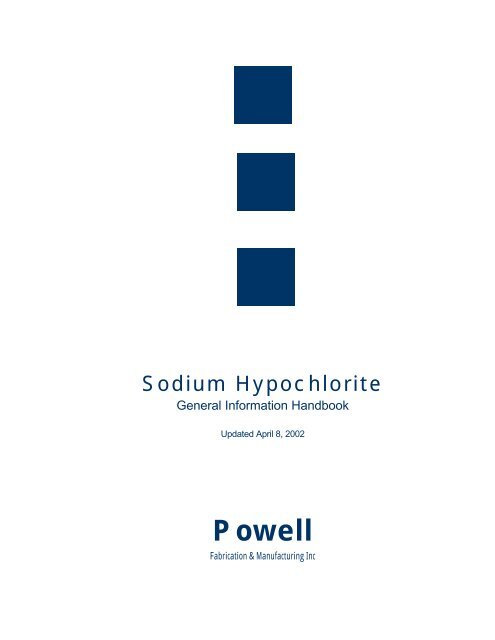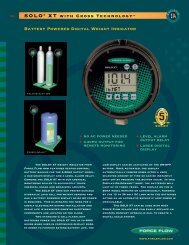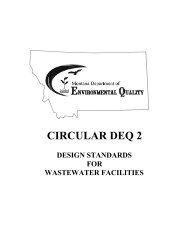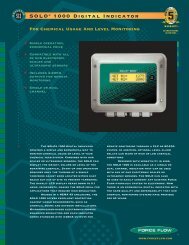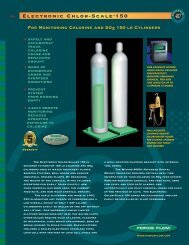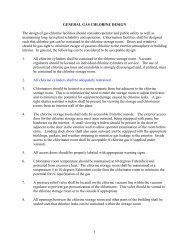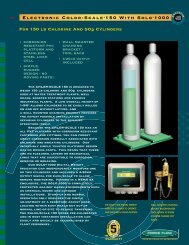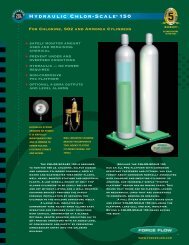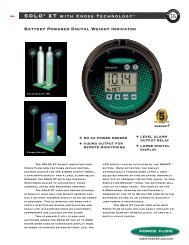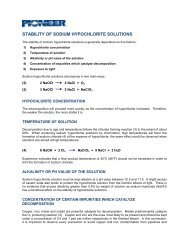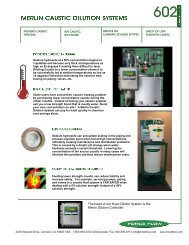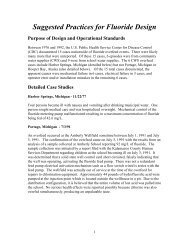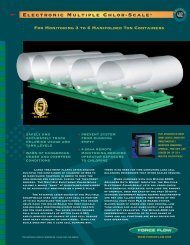Sodium Hypochlorite Handbook - Force Flow
Sodium Hypochlorite Handbook - Force Flow
Sodium Hypochlorite Handbook - Force Flow
Create successful ePaper yourself
Turn your PDF publications into a flip-book with our unique Google optimized e-Paper software.
2.2 Terms Used to Define the Strength of <strong>Sodium</strong> <strong>Hypochlorite</strong>In various parts of the world, sodium hypochlorite strength is identified using five common definitionsthat result in different numbers for the answer although the oxidizing power is the same, i.e. the sodiumhypochlorite strength is the same. Although there are other definitions used, due to the infrequency ofuse, these definitions will not be discussed.The terms to define the sodium hypochlorite strength commonly used in the industry are as follows:2.2.1 Grams per Liter of Available ChlorineThe weight of available chlorine in grams in one liter of sodium hypochlorite solution. This weight isdetermined by analysis. Testing methods are available from many sources. Powell has worked withmany of these methods and have posted our preferred method on our website at www.powellfab.com.This method was developed to help reduce the typical problems associated with the procedures.2.2.2 Grams per Liter of <strong>Sodium</strong> <strong>Hypochlorite</strong>The weight of sodium hypochlorite in grams in one liter of sodium hypochlorite solution.It can be calculated by converting the grams per liter available chlorine into its equivalent as sodiumhypochlorite by multiplying the ratio of their respective molecular weights:Grams per liter available chlorine x NaOCL/Cl 2 or x 74/71 or 1.05 = grams per liter sodium hypochlorite2.2.3 Trade Percent of Available ChlorineA term often used to define the strength of commercial bleaches. It is identical to grams per liter ofavailable chlorine except the unit of volume is 100 milliliters not one liter. Therefore, the result is onetenth of the grams per liter.Trade % Available Chlorine = gpl available chlorine / 102.2.4 Weight Percent of Available ChlorineDividing the trade percent by the specific gravity of the solution gives weight percent of availablechlorine. Typically density measurements will result in errors of 0.5 to 1.0% (i.e. 10% could be 9.90%to 10.10%) when converting from gpl available chlorine to weight percent available chlorine.Weight % Available Chlorine =gpl Available Cl 2 / (10 x specific gravity)or Trade % Available Cl 2 / specific gravityNote: When measuring the specific gravity, measure it at the same temperature as the temperature ofthe bleach sample used in the bleach strength test.2.2.5 Weight Percent of <strong>Sodium</strong> <strong>Hypochlorite</strong>The weight percent of sodium hypochlorite is the weight of the sodium hypochlorite per 100 parts ofsolution. It can be calculated by converting the weight percent of available chorine into its equivalent assodium hypochlorite by multiplying the ratio of their respective molecular weights.Note: When measuring the specific gravity, measure it at the same temperature as the temperature ofthe bleach sample used in the bleach strength test.
Weight percent available chlorine x NaOCl/Cl 2 or x 74/71 or 1.05 = weight percent NaOClWeight percent sodium hypochlorite= gpl available chlorine x 1.05(10 x specific gravity)or = trade % Available Cl 2x 1.05specific gravityor = weight percent available chlorine x 1.05Since sodium hypochlorite is sold based on the strength of the product, it is critical to specify exactlywhich term is used to define the strength of the product.2.3 Ratio of Gallons of <strong>Sodium</strong> <strong>Hypochlorite</strong> to Pounds of Chlorine UsedIn order to calculate the volume and the strength required to replace the oxidizing power of existingchlorine applications, the strength of the sodium hypochlorite purchased must be converted to theequivalent pounds of available chlorine.For Example:Using the definition of GPL of available chlorine (weight of available chlorine in grams per liter ofbleach) the following conversion is useful:120 GPL available chlorine =120 gpl Av. Cl 2 x 3.785 liters/gallon x 2.205 pounds/1000grams = 1 pound/gallon available Cl2Therefore, one gallon of sodium hypochlorite at 120 GPL available chlorine strength will have theoxidizing power as one pound of chlorine.Other equal terms:120 GPL available chlorine = 12 Trade percentor 12/ 1.168*= 10.27* weight percent available chlorineor 10.27* x 1.05 = 10.79* weight percent sodium hypochlorite*Caution: Each manufacturer will produce sodium hypochlorite with different specific gravity due to thevariation in the amounts of excess caustic, chlorates, and salt. Therefore, all test procedures by boththe producer and the consumer should calculate the bleach strength in grams per liter availablechlorine. Therefore, if gpl available chlorine is used as the indication of sodium hypochlorite strength,the accuracy of this measurement is not dependant on the accuracy of the specific gravitymeasurement of the product.If other strengths of sodium hypochlorite are utilized such as 160 gpl, the amount of available chlorineper gallon is the ratio of the new strength versus 120 gpl. Therefore, 160 gpl to 120 gpl (160/120) is1.333 and the amount of available chlorine per gallon is 1.333 pounds per gallon since 120 gpl has1#/gallon of available chlorine.In summary, if the process uses one pound of chlorine, the process will use one gallon ofsodium hypochlorite at strength of 120 GPL available chlorine.
2.4 <strong>Sodium</strong> <strong>Hypochlorite</strong> DecompositionThe consumer must understand the reasons for decomposition of sodium hypochlorite to successfullypurchase and utilize the product and to eliminate “oxygen locking” and piping systems plugging.There are two decomposition pathways of sodium hypochlorite.The dominant pathway is as follows:3NaOCl = 2NaCl + NaClO3 (Chlorate)This decomposition can be created two major ways.2.4.1 <strong>Sodium</strong> <strong>Hypochlorite</strong> Decomposition By Chlorate Formation Path #1If during production of the sodium hypochlorite the reaction of chlorine and caustic occurs in a low pHregion of the reactor (typically less than 10 pH), hypochlorous acid is formed. This will result in chlorateformation. Refer to Section 5.0 References.In most batch production systems for sodium hypochlorite using the original methods is common in the1950 & 1960’s, high levels of chlorate can be produced during the reaction process. During the 70’s,80’s and 90’s most manufacturers have converted to continuous production of sodium hypochloriteresulting in good control of the pH at the reaction point and thus reduced chlorate formation. However,it should be noted that within the continuous sodium hypochlorite manufacturing group, individualmethods of operation will greatly affect the levels of chlorate produced during the reaction. Forexample, if packed towers are utilized for the reaction of caustic and chlorine, high levels of chloratescan be expected if the excess caustic in the column drops below approximately 1.5% by weight excess.It should also be noted that the strength of sodium hypochlorite produced during the reaction will alsoaffect the levels of chlorate. Regardless of the method used in the sodium hypochlorite production, thatproduction method will create high levels of chlorates if higher strengths of sodium hypochlorite areproduced.2.4.2 <strong>Sodium</strong> <strong>Hypochlorite</strong> Decomposition By Chlorate Formation Path #2<strong>Sodium</strong> hypochlorite after production will decompose due to initial strength and pH, storagetemperature, sunlight, and contaminants such as heavy metals and suspended solids such as calciumand magnesium.The normal rate of sodium hypochlorite without salt, sunlight, heavy metals and contaminants (whichcan be easily controlled) with a pH of 11.86-13 can be expressed as:Rate = K2 (OCl - ) 2 (Reference #1)Therefore the strength of the bleach during storage and the amounts of chlorate can be calculatedusing the predictive chemical-modeling program created by Gilbert Gordon and Luke Adam.(Reference #1)2.4.2.1 Method #1 to Reduce <strong>Sodium</strong> <strong>Hypochlorite</strong> DecompositionChlorate Formation Path #2As indicated by the decomposition formula, sodium hypochlorite has a 2 nd order rate of decomposition.This means that a 200-gpl available chlorine sodium hypochlorite solution without salt will decompose 4times faster than 100-gpl available chlorine sodium hypochlorite if all other factors such as storagetemperature are the same.However, at a constant temperature, the rate of NaOCl decomposition is also affected by the total ionicstrength of the solution. Since salt is produced in the reaction of chlorine and caustic, this increase in
ionic total strength increases the decomposition rate. In practice, a factor of 2 decrease inconcentration produces nearly a factor of 5 decrease in decomposition rate at any given temperaturewith a pH range of approximately 11 to 13.One other important concept in bleach decomposition is that due to the total ionic strength, once a 200gpl available chlorine solution decomposes to a 100 gpl solution, the 200 gpl decomposition rates aremuch greater than a 100 gpl available chlorine solution. Therefore, for any given strength andtemperature, over time the higher strength product will eventually be lower in available chlorine strengththan the lower strength product since it’s decomposition rate is greater.The reason this rate of decomposition must be understood by the consumer is that typically sodiumhypochlorite is delivered at approximately 120 gpl or 160-gpl available chlorine depending on the locallyit is produced and sold. Due to the basic chemistry of sodium hypochlorite, 160 gpl will decomposeapproximately 1.8 to 2.0 times faster than 120-gpl sodium hypochlorite and therefore chlorates will begenerated much more quickly. Since sodium hypochlorite and chlorate is always an issue in the finalproduct, then the specified delivered bleach should always be the lowest practical strength the suppliercan manufacture and deliver cost effectively.It is critical for the consumer to carefully specify the strength of sodium hypochlorite to be purchased.The length of storage time and temperature must determine the strength chosen. If the consumer isusing the product in an application that chlorate levels are critical, the chlorate formation must also beconsidered.Typically, for any storage over one week it is advisable for the end user to greatly reduce thedecomposition of the stored product. One of the best methods to reduce decomposition is to store thesodium hypochlorite at a lower strength than the delivered strength. The product must be diluted withsoft water. Plant water, well water, or city water must not be used in order to prevent the addition of thetotal dissolved and suspended solids and other contaminants with the untreated water. If 60 gplsodium hypochlorite is stored in lieu of 120 gpl, the rate of decomposition is decreased by a factor ofapproximately 5.Another benefit the consumer can receive is reduced cost of transportation. Since 160 gpl availablechlorine has 1/3 more available chlorine than 120 gpl, more available chlorine can be transported pershipment if purchased at the 160 gpl strength. Therefore, if high strength sodium hypochlorite isproduced and then diluted at the consumer’s site, the price per pound of available chlorine can bereduced.In many parts of the US and Canada and in many other parts of the world, higher strengths of bleachare available from the producer such as 180 gpl available chlorine and if so, even higher reduction incosts can be expected if the consumer can add the soft water in the storage tanks.2.4.2.2 Method #2 to Reduce <strong>Sodium</strong> <strong>Hypochlorite</strong> DecompositionChlorate Formation Path #2It is common in many small installation systems of sodium hypochlorite tanks to only have one tank forstorage. It is also common to leave some amounts of residual bleach in the storage tanks and thenwhen a new delivery of sodium hypochlorite is received, the new bleach is mixed into the existing oldbleach. This is not an acceptable practice.
For example:Assume the storage tank is 8,000 gallons in volume.Assume the old bleach remaining in the tank is 2000 gallons.Assume the old bleach was delivered at 120 gpl available chlorine, it is now one weekold, and now it has decomposed to 100 gpl.Assume the new bleach is 120 gpl and is a shipment of 5000 gallons.After mixing of the old bleach with the new bleach, the final mixed solution will be approximately 114 gplavailable chlorine with higher levels of chlorate due to the old bleach decomposition.Assume a week later at the same ambient conditions as previous week the sameamount of bleach of 2000 gallons remaining.Now the 2000 gallons of stored bleach will be lower than 100 gpl, for example 95 gpl since it was lowerto start with due to the dilution of the old with the new.Therefore, it is critical for the end user to always have two tanks for storage and use sodiumhypochlorite out of each tank to the lowest level before any new bleach is received. The twotanks should be alternated in use for the best results. Bleach strength can not be maintainedand can not be controlled if this is not done.2.4.2.3 Method #3 to reduce <strong>Sodium</strong> <strong>Hypochlorite</strong> DecompositionChlorate Formation Path #2In many countries it is common to ship strong sodium hypochlorite (> 60 gpl available chlorine) verylong distances in hot climates and store it a week or two before final sales to the end user. If this is acommon practice for the supplier, the end result will be a delivered product that is low in strength. Thisis not an acceptable practice.All bleach decomposition is dependant on temperature. For any given temperature, the higher thestrength, the faster it decomposes. In order to completely understand the decomposition of bleach withrespect to strength versus temperature please refer to the AWWA research document “MinimizingChlorate when <strong>Hypochlorite</strong> is the Chlorinating Ion.” In summary, for every 10 o C increase in storagetemperature, the sodium hypochlorite will decompose at an increased rate factor of approximately 3.5.Another relative indication of bleach decomposition is the Rate constants (k2) of sodium hypochloritedecomposition. Below is a table to show these rate constants of decomposition with respect to strengthand temperature.<strong>Sodium</strong> <strong>Hypochlorite</strong> (NaOCl) Weight %Temperature 15.89 13.46 10.82 7.93 4.7455 250 189 138 98.2 65.545 80.7 58.7 43.9 30.2 19.335 23.1 17.0 12.2 8.43 5.4525 6.33 4.68 3.22 2.19 1.5815 1.65 1.15 0.80 0.53 0.30
From the data it is indicated that storage of bleach at approximately 60°F (15° C) will greatly reduce thedecomposition of the bleach. Therefore, if bleach decomposition is a problem in storage and shipping,in many cases the problem can be solved by cooling the stored bleach before shipping, and ifnecessary cooling it upon receipt at the distribution center.At the production facility it is relatively easy to chill the bleach with a chilled water system and plate andframe heat exchangers. However, at the customer’s site or distribution location, it is usually easier toinstall the storage tanks, transport tote tanks, drums and bottles in a well insulated room or building andinstall air conditioning to cool the room.If the time from production to receipt at the final site is kept to a minimum it is common to not chill thebleach during the storage at the production site and during shipping, but to keep the bleach in an airconditioned room after receipt.In order to determine your best option, each application has to be reviewed based on bleach strength,storage temperature, and storage time.2.4.3 Minor decomposition pathway for <strong>Sodium</strong> <strong>Hypochlorite</strong>Although oxygen created by the decomposition of sodium hypochlorite is a major problem for theconsumer of bleach, it is a minor decomposition pathway of sodium hypochlorite with respect to the rateof decomposition and bleach strength.This pathway is as follows:2NaOCl = 2NaCl + O 2This oxygen formation will occur and is a problem if the heavy metals in the sodium hypochlorite are notremoved immediately after the production. Refer to section 3.5.The most common reason for this decomposition pathway and the heavy metal content is poor qualitysodium hypochlorite supplied by the producer. If the heavy metals such as nickel and copper are notremoved after production, the oxygen pathway will exist in relatively high amounts. Increasing strength,temperature, decreasing pH, and exposure to light in combination with the heavy metals will increasethe rate of this oxygen formation and increase the loss of the sodium hypochlorite.Oxygen formation created by poor quality sodium hypochlorite must be avoided by the consumer. Thepurchase of high purity, high quality bleach can be accomplished by writing detailed productspecifications and then enforcing these specifications once the product is purchased. (Refer towww.powellfab.com.)Oxygen will cause major problems for the consumer. If oxygen is formed in pump casings when thepump is not operating, the pump can “oxygen lock” just like one that is not primed and with air still in thecasing. This oxygen formation will cause the pump not to work until the casing is vented. Sincepumping systems are not typically designed to easily vent this oxygen, it is typically a time consumingprocess. During the time the pumps are not operating with flow, damage to pump seals and bearings inmagnetic drive pumps will occur since the pump is operating “dry” and it will create large maintenanceexpenses. The most important impact of this oxygen formation is the lack of chlorination during thisevent.Some of the other symptoms of the oxygen are piping systems and instrumentation systems canbecome “oxygen locked” when the product is not flowing if it contains heavy metals. This is a majorproblem if the piping layout is such that the oxygen cannot migrate to the high points of the system andvent. Loss of flow measurement will occur if some types of flow meters become “oxygen locked”.
One last indication of this problem is the experience of some producers and consumers with PVC ballvalves “exploding” when the valves are closed. This is due to the extremely high pressures createdinside the PVC ball when the heavy metals decompose the bleach. This problem has occurred oftenenough that one PVC ball valve manufacturer is offering a “blowout proof” bleach ball valve. This valvehas a hole drilled on the upstream side of the ball valve. In order to eliminate this potential safetyproblem, simply purchase bleach that has been filtered and contains extremely low levels ofheavy metals.Oxygen formation is virtually eliminated by purchasing high quality sodium hypochlorite with only traceamounts of nickel, copper and suspended solids, and by correct storage and handling of the product.When the sodium hypochlorite is used in the household at typical strengths to 7% by weight, the bleachmust not contain heavy metals since the containers are not vented and any oxygen formation will resultin the storage bottles building excessive oxygen pressure. This problem will result in a product thatcannot safely be sold since the containers may fail during transportation and handling. Thesecontainers can be recognized on the grocery store shelves by the swelling or ballooning of thecontainer.3.0 <strong>Sodium</strong> <strong>Hypochlorite</strong> QualityWhen purchasing sodium hypochlorite the consumer must be concerned with the product quality. Thepurchaser has control of the product quality with respect to bleach strength and quality. By specifying ahigh quality sodium hypochlorite that has only trace amounts of nickel, copper and suspended solids,and correct storage and handling of the product, the following benefits are achieved:• Low chlorate levels in the delivered sodium hypochlorite• Decomposition of the product can be reduced and therefore chlorate formation will be reduced• Settling of the suspended solids will be eliminated in the tanks, pumps, piping and instruments• Negligible amounts of oxygen will be produced• Safety of the piping systems is improved in PVC piping systems by eliminating the source of valveand line ruptures• Existing insoluble compounds coating and plugging feed system will be reabsorbed in the sodiumhypochlorite feed solution and future problems are eliminated.Therefore, the following items must be addressed during the quality testing of the product received.3.1 StrengthThe strength of the sodium hypochlorite is determined by titration. See Section 5.0 References.Since the specified delivered strength of the product can affect chlorate levels, the purchaser mustconsider the strength of the delivered product when specifying the sodium hypochlorite. It is importantfor the purchaser to use a standard nomenclature such as grams per liter available chlorine whenspecifying the strength of the product.3.2 Excess <strong>Sodium</strong> Hydroxide (caustic)The strength of the excess caustic or alkalinity of the solution is determined by titration. See Section5.0 Reference.The minimum amount of excess caustic in normal applications is 0.3 gpl, which is approximately 11.86pH. If the specific gravity of the sodium hypochlorite were 1.20, the 0.3 gpl excess caustic would be0.025% by weight. Any amount of excess caustic below the 11.86% will cause the pH of the solution todrop over time and will result in a much faster rate of decomposition.
A test for suspended solids is available (see Section 5.0 References, 5.6 Suspended Solids QualityTest for Bleach Using Vacuum Filtration) that is quick and the results can be duplicated from location tolocation. This test simply passes one liter of product through a 0.8 micron filter cloth under 20” ofmercury vacuum and the time to filter is noted. If the product passes the test in 3 minutes or less, theproduct has negligible suspended solids and can be accepted from the producer.The bleach producer has two completely different methods to use to achieve the required test results.The first method of manufacturing is from a producer using chlorine from railcars, 50% caustic and softwater. Since the suspended solids cannot be controlled during production due to the number ofvariables, the final product must be filtered in an extremely high efficient filter system filtering particlesin the sub micron size levels. Normally this is accomplished with a filter aided filter system using perliteor diatomaceous earth as the filter media. Rarely is the required level of filtering accomplished usingcartridge filtering due to cost, flow rate capabilities of the cartridge systems, and particle-sizelimitations.The second method of manufacturing is from producing chlorine using a membrane cell process withvapor chlorine direct from chlorine cells reacted with caustic direct from the cells that has been dilutedwith softened or demineralized water. Since the caustic and chlorine at the point of manufacture isextremely pure and the water has virtually no contaminants, the final product will be ultra pure, it willhave negligible suspended solids, and the bleach produced will pass the suspended solids test in lessthan 3 minutes.3.6 Parts per million of chlorateThe typical limit of chlorate in the delivered bleach is 1500 mg/liter (1500 PPM). The testing for thechlorate is not easily done and usually a qualified laboratory is used. See Section 5.0 References.As discussed above, the producer can control the amount of chlorate formed during production bylimiting the final strength of the product, temperature of production and controlling pH during reaction.The producer can also help control the chlorate by delivering the product a short time after production.If the product is of high purity with low levels of suspended solids and heavy metals, further reductionsof chlorate will be achieved.As discussed in previous sections, the chlorates can be minimized by reduction of the strength of theproduct during final storage and reduction of the final storage temperature.3.7 Parts per million of nickel & copperTypical specifications of nickel and copper are 50 PPB (parts per billion) or less. Unless themanufacturer has a high purity product these levels will not be achieved. As discussed above, theseheavy metals will decompose the product and should be specified. If the bleach is extremely wellfiltered typical nickel and copper content will be less than 10 PPB each.Nickel is in the 50% caustic used in production. Some methods of production for sodium hydroxideresult in higher levels of nickel and therefore carry over to the final product.Copper is introduced in the sodium hypochlorite usually due to copper water lines used for processwater piping or dilution water. The manufacturer and consumer can avoid copper in the processsystem and copper is not usually a problem.Since the heavy metals can be filtered out with submicron filter aided filter systems, the purchaser canspecify the amounts of heavy metals in the delivered product. A low heavy metal content is usually anindication that very little suspended solids is in the final product. However, the level of suspendedsolids must also be specified and tested.
3.8 Parts per million of ironTypical specifications of Iron are for less than 0.5 PPM. The Iron levels found in the normal product arenot a factor in the decomposition of the product. However, if the iron levels exceed more thanapproximately 1 PPM, the sodium hypochlorite will start to turn a slight red brown color. The higher theiron content, the more pronounced the color change.The reason iron levels are specified is that if the iron is less than 0.5 PPM; typically the only methodthis can be achieved is for the producer to use high quality filtration. This iron level specification isanother method the purchaser can use to verify the product is of high quality. High level iron content inbleach can be filtered using submicron filter aided filter systems.4.0 Transportation, Storage, and Handling <strong>Sodium</strong> <strong>Hypochlorite</strong>After all above items have been addressed on the quality of the purchased sodium hypochlorite, theconsumer must verify the correct transportation, storage and handling of the product at the user site.4.1 Transportation of <strong>Sodium</strong> <strong>Hypochlorite</strong>4.1.1 Tanker TrailersTanker trailers are tanks mounted on a frame with wheels with a fifth wheel connected to a truck tractor.These trailers are used to deliver large volumes of bleach to the customer’s site. Most of theequipment used is capable of delivering from 4,000 to 6,000 US gallons at one time. These tankerscan be of many different designs and the structural tank can be of steel or fiberglass reinforced plastic(FRP). However, they must all have materials in contact with the product that are resistive to sodiumhypochlorite.There are many different materials of construction used as the corrosion barrier for the sodiumhypochlorite to eliminate damage to the structural tank and to eliminate contamination of the product.Some of these liners include rubber, PVC, Halar®, Tefzel®, and other non-metallic material. FRPtanker trucks are very successful for hauling sodium hypochlorite when the entire container is made ofFRP with correct construction methods. However, steel tankers lined with FRP should not be used dueto the differences in expansion rates with respect to temperature changes. In the US and Canada, FRPtank trailers are replacing rubber lined steel as the material of construction due to the long life of theFRP trailer. The FRP trailer has had 30 years of use and it has been proven when the FRP trailers areconstructed correctly, they are the best choice for sodium hypochlorite.Since failure of any of these liners will result in damage to the tanker, the owner of the tanker will beinspecting the liners on an annual basis. If required, repair and replacement of the liner will be done.If a liner should start to fail during the yearly period between inspections, the purchaser may notice twochanges in the product received. First, if the tanker is steel with a liner, the iron content of the bleachwill increase over time when that tanker is used for delivery. Second, failure of a liner may result in anincrease in suspended solids.From a consumer’s perspective, other than meeting the suspended solids and the metals testing a linerfailure does not result in any problems. However, the owner of the tanker should be notified of anychanges of product quality that may be a result of a defective liner so repairs can be made to the trailer.The purchaser should specify that the tankers be cleaned if the tanker is contaminated. The only timethis may be an issue is if the company delivering the sodium hypochlorite is back hauling anothercompatible products such as sodium hydroxide and if it contaminants the product.
4.2.3 PolyethyleneThese tanks can be of linear or crosslinked polyethylene construction and usually the tanks are verticalcylindrical construction with flat bottom and domed top. Some manufacturers have a special resin forsodium hypochlorite. Outside tanks should have UV protection and should be painted white.These tanks are very competitively priced. However, since these tanks may have a service life of 5-7years, they should typically be used in location, inside or outside, where they can be easily replacedwhen they fall. These tanks should not be used in a construction application that allows for no easyreplacement of the tank upon failure.The major problem polyethylene tanks are the outlet fittings below the liquid level. In the past bulkheadfittings have been used of PVC construction. However, below the liquid level of the tanks, titaniumbulkhead fittings should be used with titanium bolting. Above the liquid level PVC bulkhead fittings areacceptable. PVC bulkhead fittings below the liquid level may be used on small tanks and inapplications where downtime due to repairs on the fittings are acceptable. Viton® gaskets are used.Many installations utilize titanium 150# flat-faced backing flange with titanium bolts welded in theflange. A Viton® full faced gasket is used between the backing flange and the inside tank wall. Theflange is located at a flat spot on the tank wall (typically 90-degree locations) and holes are drilled forthe bolts and the center is bored to meet the ID of the flange. On the outside of the tank, a gasket andvalve can then be applied which when tightened will compress the inside gasket and seal theconnection. Refer to www.powellfab.com for detailed information of this method of installation.4.2.4 Fiberglass Reinforced PlasticThe use of fiberglass tanks for storage of sodium hypochlorite is common and if designed properly canbe one of the best choices for storage of the product. However, if improperly specified and constructed,it can be one of the worst choices. A well-specified and properly constructed FRP tank can last 10-15years or more with corrosion barrier inspections typically every two years with minor repairs asrequired. An improper design and construction will result in corrosion barrier failure and structuraldamage in 3-5 years requiring complete replacement of the tank.Typical specifications for FRP tanks would include hand laid up or “ortho wound” construction but notfilament wound since failure of the corrosion barrier in a filament wound tank will result in the sodiumhypochlorite wicking around the continuous strands of glass used in the structural portion of the tank.This will result in weakening of the structural portion of the tank and may result in a catastrophic failureof the tank.Vinyl ester resin is used for both the corrosion barrier and structural layers of the tank with the inside ofthe tank corrosion barrier starting with 2 nexus veils. The corrosion barrier should not be used forstructural design. The corrosion barrier is catalyzed with a BPO/DMA cure system and a 4-hour postcure.For detailed specifications of FRP tanks for sodium hypochlorite, refer Section 5.0 for source material.There has been success with dual laminate FRP tank using PVC and other materials for the corrosionbarrier. If this method of construction is used, the best source of specifications is from themanufacturer of the tank. Consideration should be given to the detection of a liner failure beforedamage to the outside FRP vessel can occur. Only hand laid up or ortho winding should be consideredfor the FRP vessel for the same reasons as above and the FRP portion of the tank should match allspecifications of an FRP-only, tank in case the PVC lines should fail.
4.2.5 Rubber Lined SteelRubber lined steel tanks have been successfully used for sodium hypochlorite storage using chlorobutyllinings of typically ¼” thickness. These linings require a skilled applicator and heat curing.Unfortunately, depending on the type of rubber and the skill of the applicator the service life is normally3-6 years at which time the liner may require total replacement.Liner replacements can be done in the field so inside locations of the tanks are not a problem.However, if the liner failure is not recognized in time, the steel tank will be chemically attacked bysodium hypochlorite resulting in iron contamination of the product and structural damage to the tank.For these reasons, rubber lined tanks are not typically used in sodium hypochlorite storage althoughthey may be used in a processing tank for structural integrity due to pressure requirements.4.2.6 TitaniumTitanium storage tanks are the best choice of material for sodium hypochlorite. The grade typicallyused is commercially pure grade 2. However, the cost of titanium storage tanks is prohibitive unlessthere is a requirement for virtually unlimited service life with no failures allowable.Normally, titanium tanks are only used for process tanks to handle special applications such aspressure reactors or small process tanks if time for repairs cannot be tolerated.4.3 Materials of construction4.3.1 Incompatible materials of constructionIf the wrong metals materials of construction are used in any portion of the process systemcontamination of the product will occur resulting in accelerated decomposition and potential additionaloxygen formation depending on the materials of construction. All metals should be avoided excepttitanium, tantalum, silver, gold, and platinum. Metals such as stainless steel, Hastolley®, Monel®,brass, or copper should be avoided at all cost. These incompatible metals can be found in pumps,pump seals and water flush lines, electrodes in magnetic flow tubes, diaphragm seals for gauges andswitches, temperature wells, and common piping elements such as hose connections and valves.Although copper piping is typically used for industrial applications for water supplies and the dischargepiping from water softeners, this piping should not be used for dilution water in either the bleachproduction or the consumer facility for dilution of caustic or bleach. Very small amounts of anincompatible metal will result in large amounts of product decomposition and oxygen formation. Theconsumer must review each component in the pumping and piping system including all instruments toensure no incompatible materials are used.4.3.2 Compatible materials of ConstructionFor metals in contact with sodium hypochlorite, the majority of construction for all process equipment istitanium. Tantalum is used for electrodes in magnetic flow meters and diaphragm seals. Silver andplatinum are used for electrodes to measure oxidation-reduction potential. There should be no othermetal in contact with sodium hypochlorite except in rare occasions for special applicationsplatinum/iridium and titanium/palladium combinations will be used.For non-metallic materials in contact with sodium hypochlorite, the list includes PVC, Teflon®, Tefzel®,Kynar®, Halar, polyethylene, FRP and co-polymers such as “Section 4.5.2”. CPVC a listed material butafter a few years of use, it has a tendency to get brittle and a risk of failure is higher than the PVC.Many of the non-metallic materials are used as liners inside of metals. The non-metallic provides thecorrosion protection and the metals provide the structural strength. There are few systems usingtypically PVC liners with FRP as the structural component. Any non-metallic exposed to the sun musthave a UV barrier on all exterior components. A paint system designed for UV protection is the leastexpensive and when FRP is utilized, a gel coat is the typical method. Since these paint systems or gelcoats will deteriorate over time, they must be reapplied as required.
4.4 PumpsThe choice of pumps for sodium hypochlorite depending on the application can be separated intocentrifugal and positive displacement such as diaphragm. In all applications, the only metal acceptableis titanium. However, many non-metallic pumps can be used with or without the structural metal orFRP component.One of the best centrifugal pumps for sodium hypochlorite is a titanium pump. However, these pumpsare expensive compared to other choices and the design cannot avoid the use of seals. There aremany good seals available for these pumps and the purchaser should refer to the manufacturer fordetailed recommendation. However, any good seal will only last typically 3-5 years and will requirereplacement. Since good seals are expensive, depending on the application a less expensive magneticdrive pump can be used and even though the pump will not last as long, total cost of operation will beless than a titanium pump.Therefore, for centrifugal applications, the best choice of pump may be a lined steel magnetic drivepump. Linings of Teflon®, Tefzel® and other non-metallic materials are used. These pumps may onlylast from 3-7 years but depending on the pump, 2 or 3 pumps with spare parts can be purchased for thesame cost as a titanium pump. If a magnetic drive pump is used, a power monitor must be used toprevent dry running of the pump and damage to the shaft and bearings.There are many choices of diaphragm pumps for small flow applications. Many choices for the pumphousings are available and successful. The diaphragms can be of Teflon® or some rubbercompounds. However, if rubber compounds are used, Viton® is the preferred choice. EPDM issuccessful but may not have as long as service life as Viton®.There are other types of pumps available and they may be used for special applications. Pump choicesshould be made based on manufacturer’s recommendations and customer satisfaction.4.5 Piping4.5.1 PVCTypical choice for low-pressure piping is PVC Schedule 80 socket welded pipe and fittings. Do not usethreaded joints for sodium hypochlorite connections if possible. Over time, a threaded joint will have atendency to leak and threading the pipe reduces it structural integrity.PVC piping should not be used for high pressure, typically over 50 to 60 pounds since failures result inpotential injury. If higher pressures are used with PVC, use soft start motors on pumps and slowopening and closing valves if automated valves are used to start and stop flows. Velocities in PVCsodium hypochlorite piping systems should not exceed 7 feet/second and better results will be achievedif the velocities are kept less than 5 feet/second. Care must be taken to use an industrial grade cleanerand glue for the PVC and to follow the manufacturer’s installation instructions. PVC installed outsidemust have UV protection.4.5.2 Lined PipeFor high pressure or very long service life, a lined piping system typically of Teflon® is used includingcarefully designed expansion joints. Linings are usually PTFE and fittings and pipe are a 150# flangeddesign. These systems are expensive but can result in 20-30 year service life. Other liners can beused such as Kynar, Tefzel, and Halar but based on cost and service life and successful applicationsPTFE appears to be the best choice.4.5.3 Titanium PipeLightweight schedule 5 and 10 titanium pipe can be used for very long runs for sodium hypochlorite.These are welded systems with carefully designed expansion joints. In some larger piping systems,titanium can be a cost effective method of piping compared to a lined pipe system and betterperformance can be achieved since most flanged joints are avoided.
4.5.4 FRP PipeStandard FRP available from the typical manufacturer is not successful in sodium hypochloriteapplications. If the pipe is specified and manufactured correctly with the right materials, corrosionbarriers and catalysts systems, FRP can be successful. However, the normal purchaser of pipe andfittings does not have the expertise for these FRP piping systems and they should be avoided.If FRP is the piping system of choice, then location of a qualified FRP piping manufacturer who has theexperience and knowledge to specially fabricate this FRP must be located. The FRP specifications forthe pipe would be very similar to the FRP tanks.4.6 ValvesIn general the valve materials should match the piping system in similar construction for compatibilityand weight considerations. However, the first tank valve on the outlet of the storage tank should be ofvery high quality and a lined steel plug, ball, or butterfly valve should be considered. Gear drives arerecommended in high torque applications to reduce the stress on the nozzle connection.Many different types of valves have been successful in sodium hypochlorite. However, seals shouldtypically be Teflon® and rubber compounds should be Viton® for O-rings and diaphragms.Only flanged or socket welded valves should be used. Do not use threaded. Union style ball ordiaphragm valves provide a leak path past the O-ring seal at the union joint and should be avoidedunless the valve can be easily replaced and downtime is not important.4.7 GasketsWhen low torque is required for non-metallic systems, Viton® or expanded Teflon® (WR Gore) shouldbe used. EPDM is a second choice and will work. The harder Teflon® gaskets should not be used in alow torque application.Expanded Teflon® gaskets may be used for lined pipe systems mating to a titanium flange such aspumps and heat exchangers.Due to cost considerations, plate and frame heat exchangers use EPDM with acceptable results.4.8 InstrumentationThere are many types of instruments used for sodium hypochlorite service. Most plastic or plastic linedmaterials such as PVC, CPVC, Teflon, Tefzel, halar, and other materials will work well for theinstrumentation construction. However, when metal is used in any part of the construction, onlytitanium or tantalum components can be used for contact with the sodium hypochlorite. For pH, ORPand magnetic flow meter electrodes; silver, platinum, gold, tantalum, or titanium are the only materialsacceptable if a metal is required.Since only small amounts of nickel will decompose sodium hypochlorite rapidly, Hastelloy® must neverbe used. Hastelloy® in most corrosion books under sodium hypochlorite may indicate an acceptablecorrosion rate for equipment components. However, the nickel from the Hastelloy® will decompose theproduct. Understand that corrosion tables indicate corrosion rates for the metal in a given product andno consideration is provided for the effect on the product.Since there are many types of instrumentation applications, no attempt is made to review all of them.However, in critical flow applications typically magnetic flow or mass flow instrumentation is used andflow is controlled with very high quality lined steel ball or globe style valves with 50 to 1 turn downratios. These valves are typically air to open, spring to close with 4-20 mA positioners. Electricallydriven control valves are only moderately successful for long service life applications and may notprovide the desired control.
5.0 References5.1 Minimizing Chlorate Ion Formation in Drinking Water when <strong>Hypochlorite</strong> Ion is theChlorinating AgentPublished by American Water Works Association (AWWA) Research FoundationPrepared by Gilbert Gordon and Luke Adam, Miami University, Oxford, Ohio & Bernard Bubnis,Novachem, Oxford, OhioAvailable at: AWWA Research Foundation5.2 Bleach Stability and Filtration (3306)Present at AWWA Water Quality Technology Conference, November 1996Prepared by Gilbert Gordon, Miami University, Oxford, Ohio & Bernard Bubnis, Novachem,Oxford, OhioAvailable at: www.powellfab.com5.3 Bleach Decomposition: Manual Calculation Method (3305)Prepared by Bernard Bubnis, Novachem, Oxford, OhioAvailable from Powell Fabrication & Manufacturing Inc5.4 Effectiveness of Filtering Liquid Bleach (3670)Prepared by Hung A Pham, Miami University, Oxford, OHAvailable at: www.powellfab.com5.5 The Weight Percent Determination of <strong>Sodium</strong> <strong>Hypochlorite</strong>, <strong>Sodium</strong> Hydroxide, <strong>Sodium</strong>Carbonate and <strong>Sodium</strong> Chlorate in Liquid Bleach (1250)Prepared by Bernard Bubnis, Novachem, Oxford, OhioAvailable at: www.powellfab.com5.6 Suspended Solids Quality Test for Bleach Using Vacuum Filtration (3370)Prepared by Bernard Bubnis, Novachem, Oxford, OhioAvailable at: www.powellfab.com5.7 Liquid <strong>Sodium</strong> <strong>Hypochlorite</strong> Specification (99)Prepared by Powell Fabrication and Manufacturing, IncAvailable at: www.powellfab.com5.8 <strong>Sodium</strong> <strong>Hypochlorite</strong> Safety and Handling, Pamphlet 96Prepared by The Chlorine Institute, Inc.Available at: The Chlorine Institute, Inc.: www.cl2.com5.9 <strong>Sodium</strong> <strong>Hypochlorite</strong> Fiberglass Reinforced Plastic (FRP) Storage Tank Specification(250spec)Prepared by Powell Fabrication & Manufacturing, Inc.Available at: www.powellfab.comPowellFabrication & Manufacturing Inc740 East Monroe Road • St. Louis MI 48880Phone 989.681.2158 • Fax 989.681.5013e-mail info@powellfab.com • website www.powellfab.com


